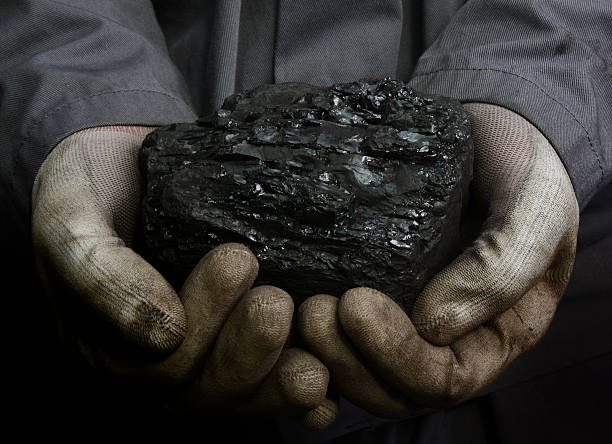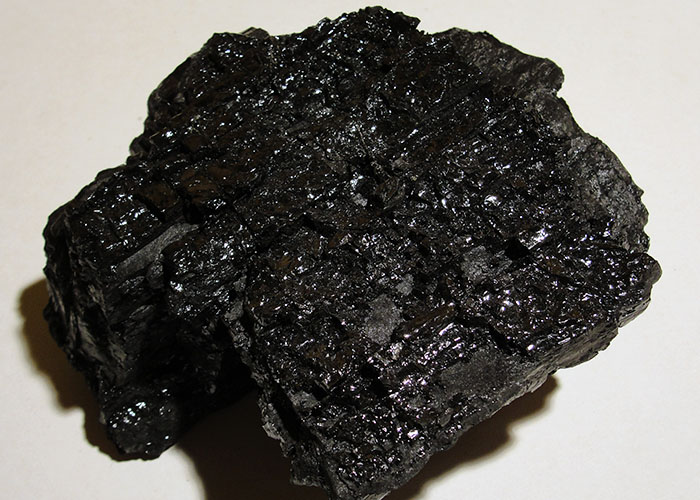
Bituminous coal

General Description of Bituminous coal
Bituminous and sub-bituminous coal represents more than 90 percent of all the coal consumed in the United States. When burned, the coal produces a high, white flame. Bituminous coal is so-called because it contains a tar-like substance called bitumen. There are two types of bituminous coal: thermal and metallurgical.
It’s the type of coal that is most widely used in our world today. It’s been named so because of the presence of a tar-like & gluey type substance that is known as bitumen.
Bituminous type coals are formed & created when a sub-bituminous type of coal is exposed to heating & very high pressure. Based on the coals volatility, bituminous type coals are divided into the categories of low-volatile bituminous coal, medium-volatile bituminous coal & finally high-volatile A, B, & C bituminous coal.
Bituminous coal also called soft coal, the most abundant form of coal, intermediate in rank between sub-bituminous coal and anthracite according to the coal classification used in the United States and Canada. In Britain bituminous coal is commonly called “steam coal,” and in Germany, the term Steinkohle (“rock coal”) is used. In the United States and Canada, bituminous coal is divided into high-volatile, medium-volatile, and low-volatile bituminous groups. High-volatile bituminous coal is classified on the basis of its calorific value on a moist, ash-free basis (ranging from 24 to 33 megajoules per kilogram; 10,500 to 14,000 British thermal units per pound), while medium-volatile and low-volatile bituminous coals are classified on the basis of the percentage of fixed carbon present on a dry, ash-free basis (ranging from 69 to 78 percent for medium-volatile and from 78 to 86 percent for low-volatile bituminous coal). Medium-volatile and low-volatile bituminous coals typically have calorific values near 35 megajoules per kilogram (15,000 British thermal units per pound) on a dry, ash-free basis.
Bituminous coal is dark brown to black in colour and commonly banded or layered. Microscopically, three main groups of macerals (individual organic constituents of coal) can be recognized: vitrinite, liptinite, and inertinite. The glassy material in most bituminous coal is vitrinite, composed of macerals derived primarily from woody plant tissue. Because of its relatively high heat value and low (less than 3 percent) moisture content, its ease of transportation and storage, and its abundance, bituminous coal has the broadest range of commercial uses among the coals. It has long been utilized for steam generation in electric power plants and industrial boiler plants. In addition, bituminous coals that contain a fairly small amount of sulfur and cake (or “agglomerate”) easily are the only coals suited for making metallurgical coke—a hard, sponge-like substance of almost pure carbon important for smelting iron ore.
A major problem associated with the burning of bituminous coal is air pollution. Burning bituminous coal with a high sulfur content releases sulfur oxides into the air. Under certain conditions, nitrogen present in coal is also released in the form of nitrogen oxides. When moisture in the atmosphere reacts with these gases, acids such as sulfuric acid are produced and fall to Earth as wet acid deposition (acid rain)—an agent that can damage buildings and crops and cause water pollution. Because of these serious pollution problems, and regulations stemming from the 1990 Clean Air Act, a growing number of coal-fired electric power plants in the United States have either installed cleaning devices to reduce air pollution emissions or switched to low-sulfur sub-bituminous coal. Some European countries have instituted similar measures, while others, such as France, have largely switched to nuclear power for the generation of their electricity. Many developing countries, such as China, seem to ignore the pollution problem altogether.
Types of Bituminous Coal

- Thermal coal, sometimes called steaming coal, is used to power plants that produce steam for electricity and industrial uses.
Trains that run on steam sometimes are fueled with “bit coal,” a nickname for bituminous coal.
- Metallurgical coal, sometimes referred to as coking coal, is used in the process of creating coke necessary for iron and steel production. Coke is a rock of concentrated carbon created by heating bituminous coal to extremely high temperatures without air. This process of melting the coal in the absence of oxygen to remove impurities is called pyrolysis.
Characteristics of Bituminous Coal
Bituminous coal contains moisture up to approximately 17 percent. About 0.5 to 2 percent of the weight of bituminous coal is nitrogen. It’s fixed carbon content ranges up to approximately 85 percent, with ash content up to 12 percent by weight. Bituminous coal can be categorized further by the level of the volatile matter it contains: high-volatile A, B, and C, medium-volatile, and low-volatile. Volatile matter includes any material that is liberated from the coal at high temperature.
In the case of coal, the volatile matter may include sulfur and hydrocarbons.
Heating value: Bituminous coal provides approximately 10,500 to 15,000 BTU per pound as mined.
Availability: Bituminous coal is abundant. More than half of all available coal resources are bituminous.
More than half of all available coal resources are bituminous.
Mining locations: In the U.S., bituminous coal can be found in Illinois, Kentucky, West Virginia, Arkansas (Johnson, Sebastian, Logan, Franklin, Pope, and Scott counties), and locations east of the Mississippi river.
Properties of Bitumen coal
The main issue of bitumen coal is particulate matter (PM), sulfur oxides, and nitrogen oxides. Some metals like lead and mercury, hydrocarbons like methane, alkanes, alkenes, benzenes, and others are also released. Some unburned substances like carbon monoxide and various organic compounds are released even under proper boiler operating conditions.Bitumen coal has two sub product; thermal or steam coal and metallurgical coal. Metallurgical or coking coal is baked in ovens in the absence of oxygen at temperatures as high as 1,100 °C (2010°F). This process is called pyrolysis. By this process, the coal is melted and the volatile constituents and impurities are driven off. Finally, the end product is pure liquified carbon which solidifies into coke.
It is completely opaque & soft
It is banded, or layered & dark gray to black in color
It’s moisture content is approximately 2 to 17%.
It’s carbon content is approximately 45 to 85%
It has a content of ash that is approximately 2 to 14% & it also contains 0.5 to 2 % of nitrogen.
It’s chlorine content is approximately 340 ± ppm & it’s sulfur content is approximately 0.5 to 5 %
Bituminous coals usually also have closely-spaced fractures found in them. Cleats also form in 2 different sets, both at right angles to each other.
Bituminous coals are very highly combustible & they release an excessive smoke as well as soot if they are not burned in a proper way. The main pollutants that come from bituminous coal are sulfur oxides, particulate matter & nitrogen oxides.
There are also some metals found in them like lead & mercury, as well as hydrocarbons like methane, benzenes, alkenes as well as others that are also released from them. Some unburned substances can be found in them like carbon monoxide as well as various different organic compounds are also released from them, even under the proper operating conditions of a boiler.
The sulfur that’s present in a higher degree in this type of coal can bring acid rain.
This coal type has heating values that are 10,000 to approximately 15,000 British thermal units (also called BTU’s) per pound, this is quite higher than that of a lignite or sub-bituminous type coal.
They have a much lower fixed carbon & a much higher volatile content than that found in anthracite.
Bituminous type coals have just 2 subtypes call steam coal / thermal coal & metallurgical coal. Metallurgical coal also called coking coal is coal that is baked in ovens in the complete absence of oxygen and at great temperatures as high as 2010°F. This type of process is what is called pyrolysis. In this type of process, the coal is melted & all of it’s volatile constituents & impurities are there by driven off. Finally, the end product that is produced is a pure liquefied carbon which solidifies.
As for the most part, bituminous type coal contains a glassy type of material that is called vitrinite. It’s composed of minerals, of which it gets this trait from a woody plant tissue.
Uses of bitumen coal
Bitumen coal is used in drilling fluid for several propose.The main usage is emulsifiers, foamers, defoamers, wetting agent, detergent and especially lubricant and corrosion inhibitors.Bitumen coal is reasonable and anticipates further advance in the application of surfactants to making the hole and improving productivity.
It is used to fire power plants electricity production power plants.
It’s used for a fuel to produce the steam that runs train locomotives.
This type of coal was also previously used for a fuel for in domestic / home water heating.
Coking coal or metallurgical coal has a high heat resistance & it’s used to create a product called coke (not the soft drink), which is then added to a blast furnace and combined with iron ore as well as limestone to produce steel.
Bituminous coal is made free from sulfur, ash, as well as some other impurities, & it’s used in coal forges, in which metals are heated & then shaped.
Due to the many different serious pollution issues that bituminous coal produces, the electric power plants found in the United States, as well as some of the European countries, have set up their coal burning power plants with cleaning devices that are used to minimize their air pollution emissions.
Bitumen coal price
We are selling bitumen coal as per plats rate FOB of Bandar Abbas in bulk or jumbo bag in rock form. The selling rate is minus 5USD per ton.
Environmental Concerns
Bituminous coal lights on fire easily and can produce excessive smoke and soot — particulate matter — if burned improperly. Its high sulfur content contributes to acid rain.
Bituminous coal contains the mineral pyrite, which serves as a host for impurities such as arsenic and mercury. Burning the coal releases trace mineral impurities into the air as pollution. During combustion, approximately 95 percent of bituminous coal’s sulfur content gets oxidized and released as gaseous sulfur oxides.
Hazardous emissions from bituminous coal combustion include particulate matter (PM), sulfur oxides (SOx), nitrogen oxides (NOx), trace metals such as lead (Pb) and mercury (Hg), vapor-phase hydrocarbons such as methane, alkanes, alkenes and benzenes, and polychlorinated dibenzo-p-dioxins and polychlorinated dibenzofurans, commonly known as dioxins and furans. When burned, bituminous coal also releases hazardous gasses such as hydrogen chloride (HCl), hydrogen fluoride (HF) and polycyclic aromatic hydrocarbons (PAHs).
Incomplete combustion leads to higher levels of PAHs, which are carcinogenic. Burning bituminous coal at higher temperatures reduces its carbon monoxide emissions.
Therefore, large combustion units and well-maintained ones generally have lower pollution output. Bituminous coal has slagging and agglomerating characteristics.
Bituminous coal combustion releases more pollution into the air than sub-bituminous coal combustion, but due to its greater heat content, less of the fuel is required to produce electricity. As such, bituminous and sub-bituminous coals produce approximately the same amount of pollution per kilowatt of electricity generated.
